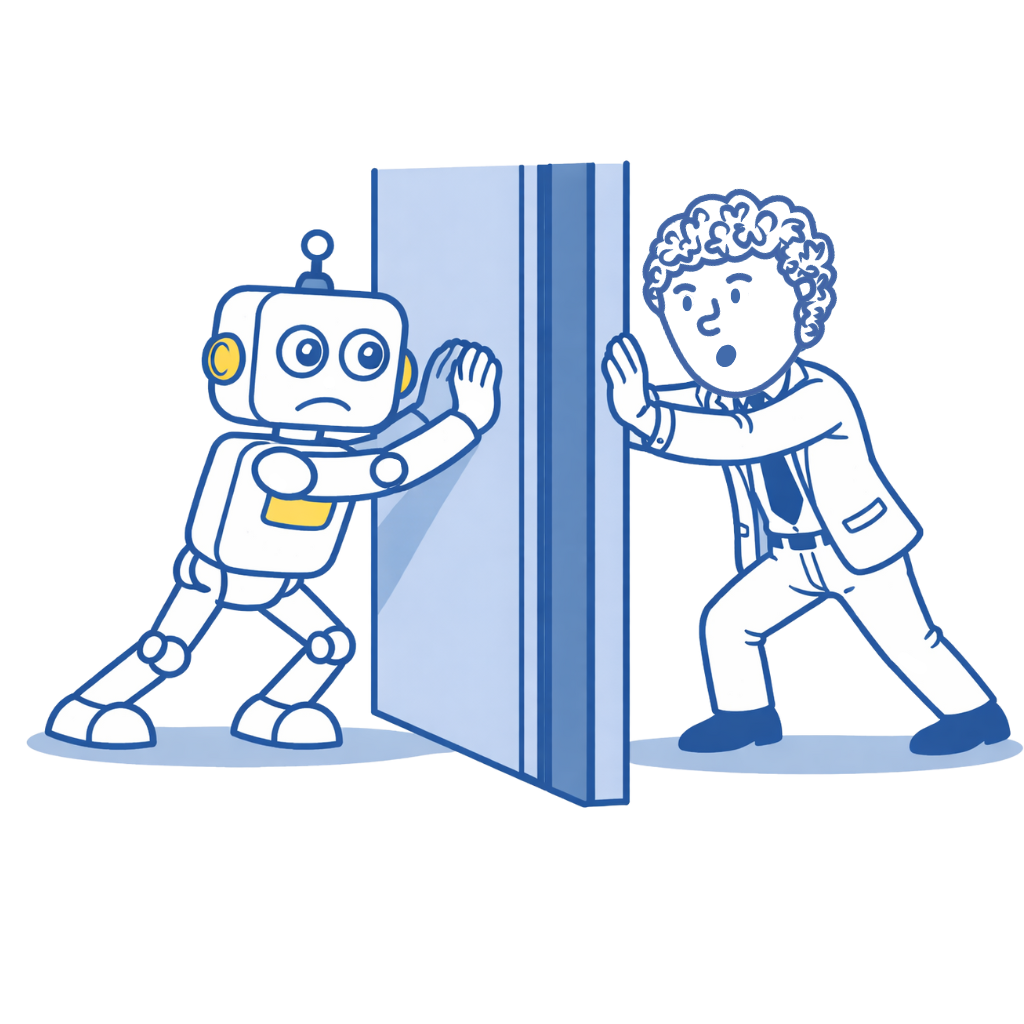Table of Contents
- Interest in link building is at an all-time high
- Digital PR interest is also at an all-time high
- Backlinks and DR are less correlated with appearing in AI Overviews than brand mentions
- Digital PR is rated the most effective link building tactic
- 65% of users still click on traditional blue links
- Higher ranking posts have more referring domains on average
- Links may matter even more in local terms
- Guest posting has seen the most significant increase in the past few months
- 85.3% of the guest posting sites are low quality (defined as DR < 40 and < 10K monthly organic traffic)
- The average cost of a high-quality or top-tier guest post is $692–$957 (vendor prices can exceed $3K)
When I wrote this report last year, interest in link building had remained almost flat for five years.
And although the effectiveness of different link building strategies and tactics has changed, something is boosting interest in link building to all-time highs since Feb 2025.
You’ll see this in the very first bullet.
In this new and improved collection of link building statistics gathered midway through 2025, I wanted to tell the story as what’s driving this surge.
I also wanted to compile some takeaways and research to help you understand what works, what doesn’t, the challenges link builders face, and more.
1. Interest in link building is at an all-time high.
Let’s start with the most relevant statistic: According to Google Trends data, interest in link building is at an all-time high.
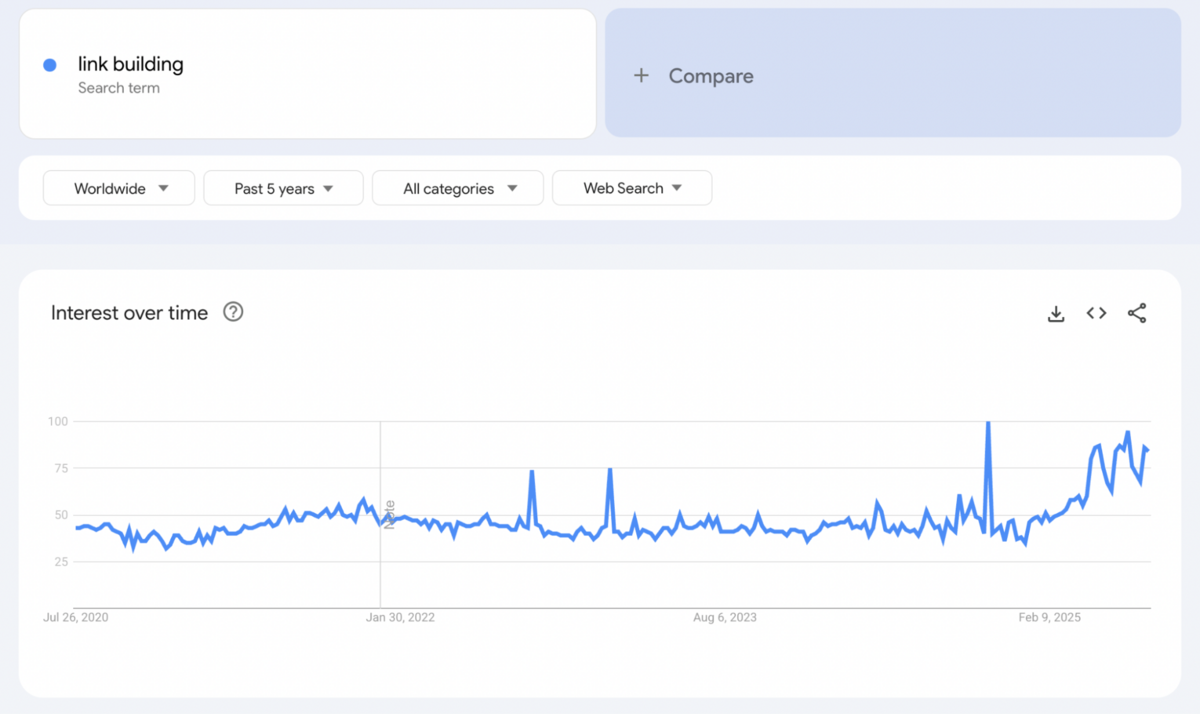
For all the talk from Google in 2024 that “links aren’t as important”, it seems that building links still is a high priority for people.
Starting around February 2025, we’ve seen an uptick in interest via Google Trends in the term “link building.”
I posted this on LinkedIn and someone had the thought that this maybe meant it was because people were searching for terms like “does link building matter” or “is link building important anymore” but that is definitely not the case.
In terms of why this is trending, I think it ties into a lot of what you’ll see in this report.
Really, the interest is in how to rank in AI, and link building is still one avenue SEOs are trying to take.
You can see it trending at the same exact time.
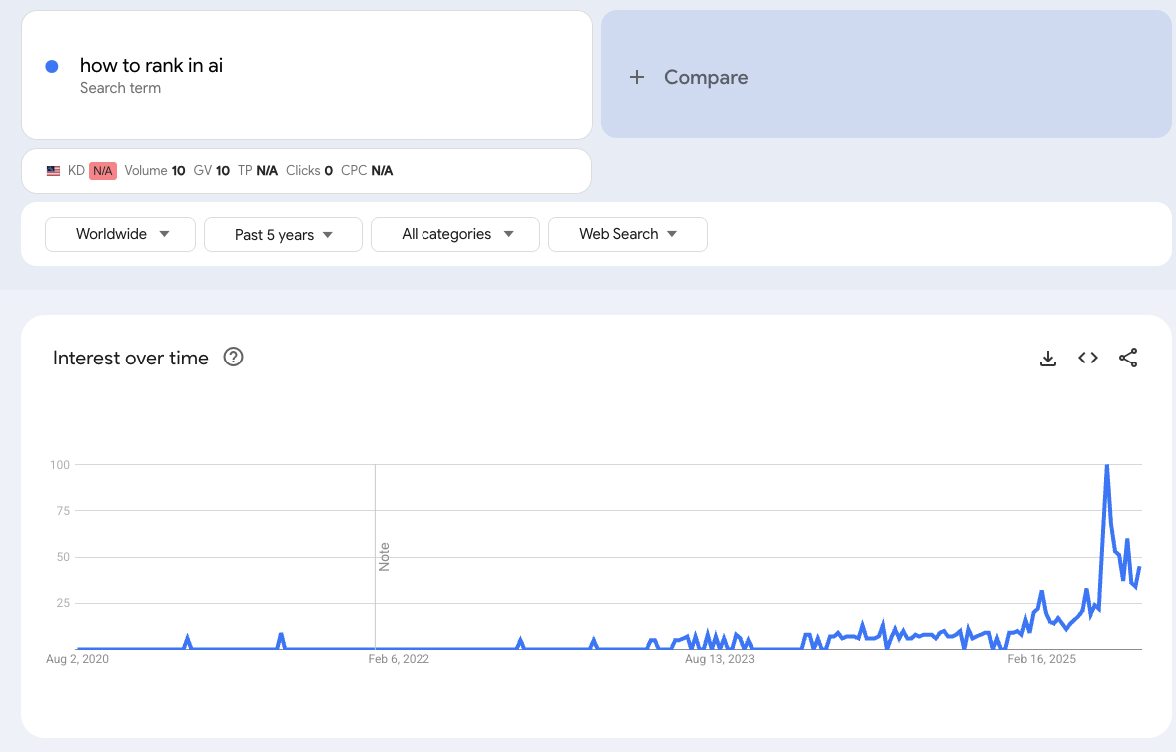
AI still appears to use citations from the top 10 search results about 75% of the time, according to a recent study from Ahrefs.
And, as features like AI Mode and underlying processes like grounding (where AI essentially supplements its answers with info search results) become more common, ranking well still seems to matter for showing up in AI responses.
So, there is still a push to generate links.
2. Digital PR interest is also at an all-time high.
Similarly, Google Trends shows that digital PR is pushing all-time highs in interest.

This is most likely again because, according to an Ahrefs study, brand mentions are highly correlated with being mentioned in AI Overviews (as seen in the next stat.).
Then there was the Ahrefs study, along with similar studies from Ziff Davis, which found that high-end news sites were being used to curate LLM datasets.
We also had the Google Leak, which highlighted the fact that Google highly values links from highly authoritative, highly engaged sites that are frequently updated, such as news sites.
Add those up, and marketers are flocking towards digital PR like never before.
3. Backlinks and DR are less correlated with appearing in AI overviews than brand mentions
As mentioned, I believe that one of the main reasons digital PR has gained popularity is due to the surprising correlation Ahrefs found between unlinked branded web mentions and visibility in AI Overviews, as well as the number of referring domains.
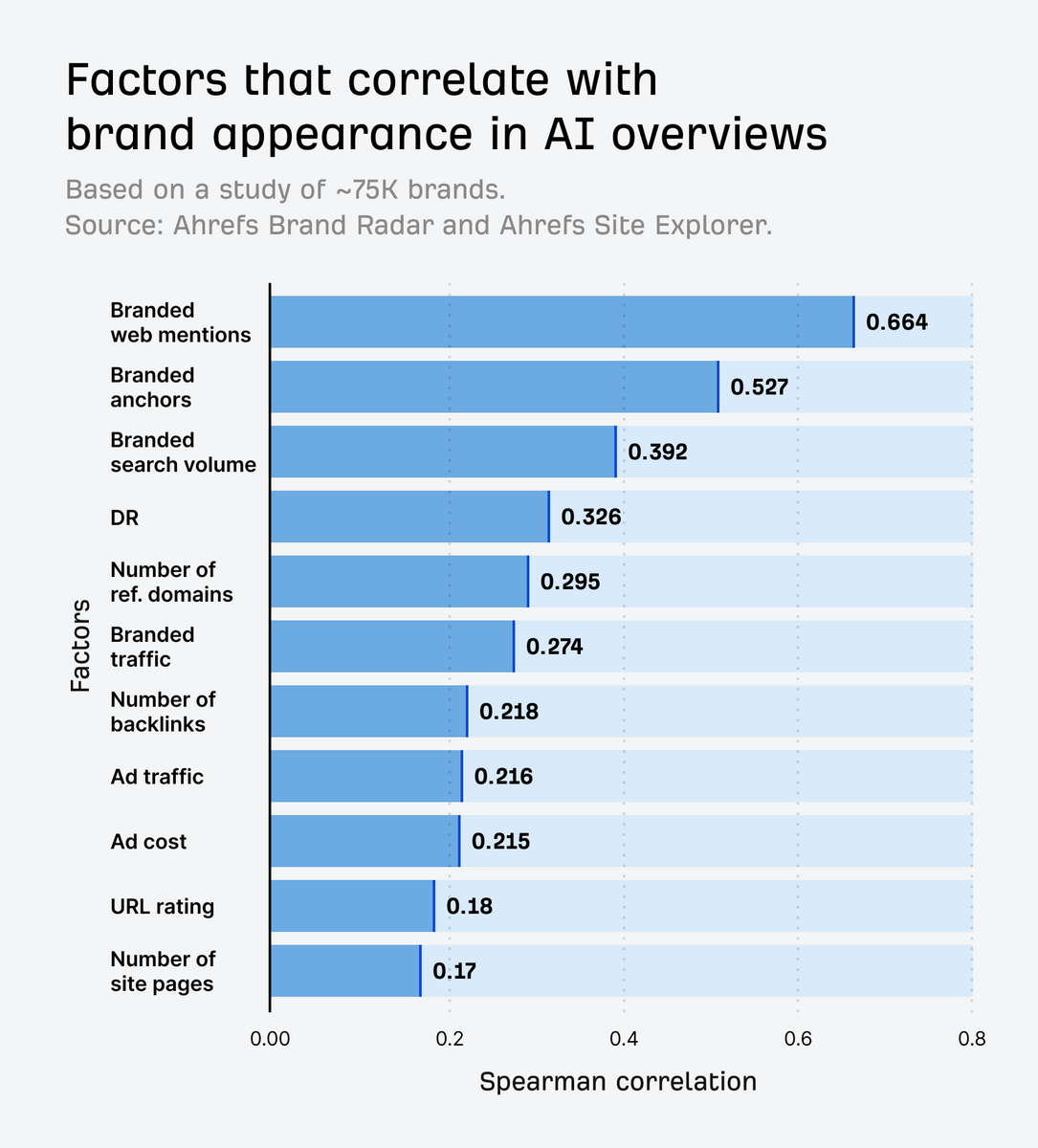
Referring domains and backlinks are still lightly correlated with appearing in AI Overviews, but to a lesser extent than branded web mentions.
4. Digital PR is rated the most effective link building tactic
Editorial.Link’s newest State of Link Building study found that 48.6% believe digital PR is the most effective tactic for 2025.
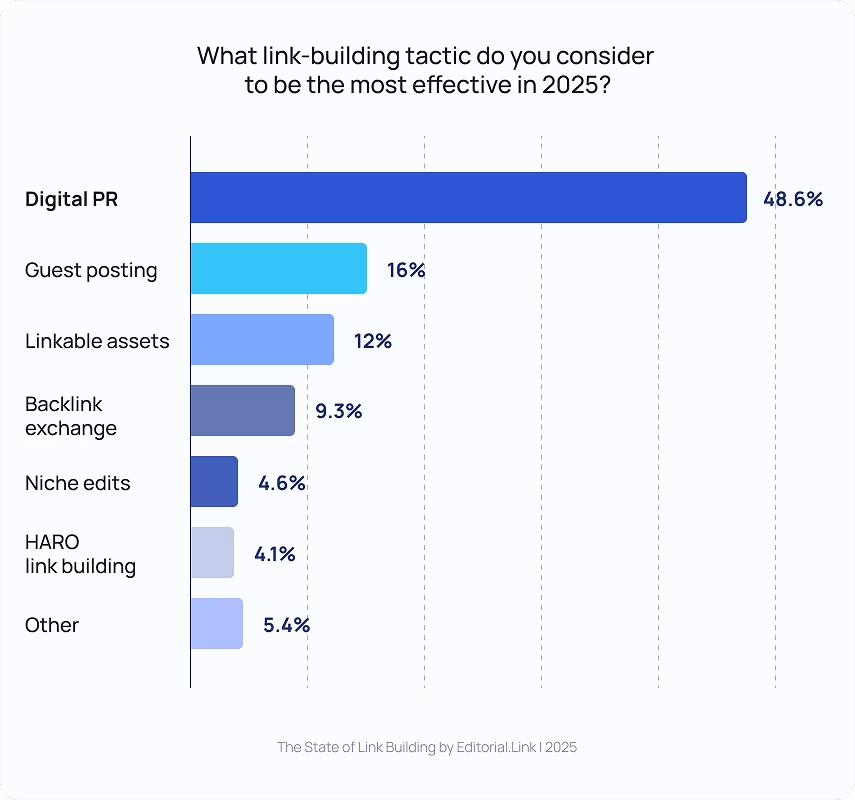
You can see this for the second consecutive year. Here is their study from last year:
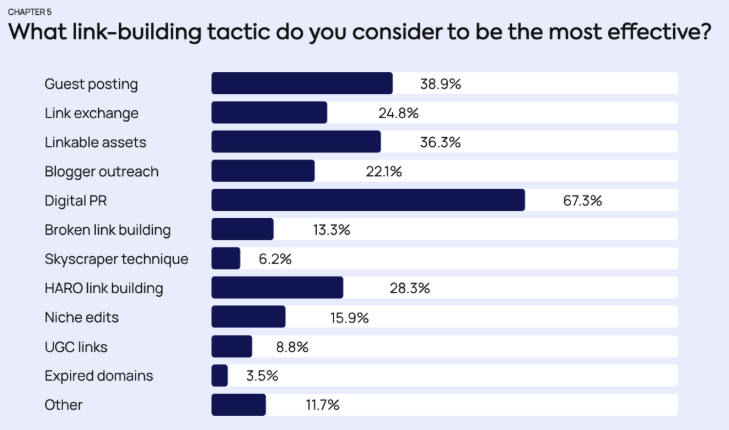
This is the main reason BuzzStream has invested so much in creating our media list building tool, ListIQ, for digital PRs.
While many scramble to appear in AI results, it seems that those who are having success are the ones trying to build a brand.
However, should brands completely give up on ranking in the traditional blue links?
5. 65% of users still click on traditional blue links
A study by Backlinko found that 65% of users still click on traditional blue links, so it’s not time to ditch the SERP results just yet.
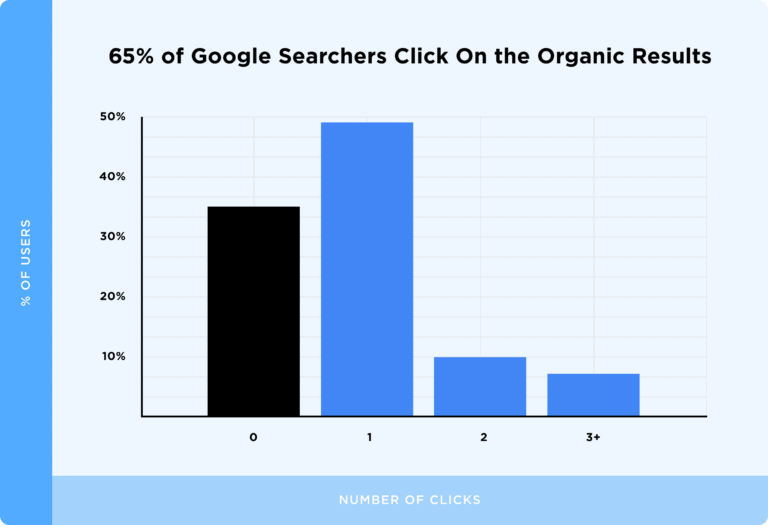
The way users search is constantly changing. Google outright told us at a Search Central NYC event to expect less organic traffic than before.
Will this trend hold?
I would expect it to decrease slightly in the coming years, but as we’ll see, if you’re looking to increase traditional rankings, links still hold significant power.
6. Higher-ranking posts have more referring domains on average
Another Ahrefs study, entitled “Google Says ‘Links Matter Less’—We Looked at 1,000,000 SERPs to See if It’s True,” found that referring domains do still correlate with ranking in Google search.
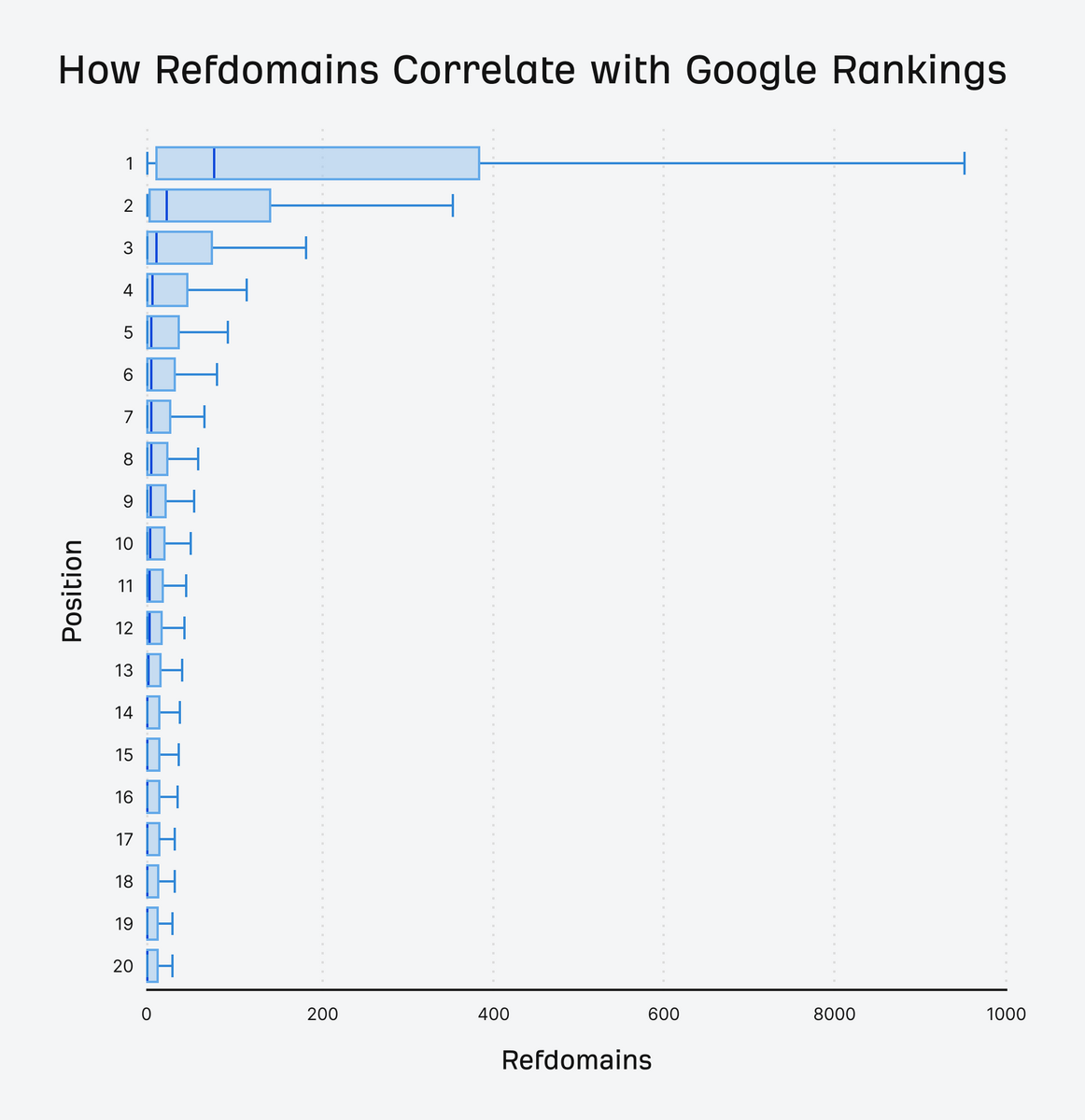
Although showing up in AI results is the “hot” new thing, a majority of users are still using and clicking on the traditional blue links.
7. Links may matter even more in local terms
In the same Ahrefs study mentioned above, they also found that in local queries, such as “best steaks in San Diego,” backlinks and referring domains are more highly correlated with ranking than in non-local search terms.
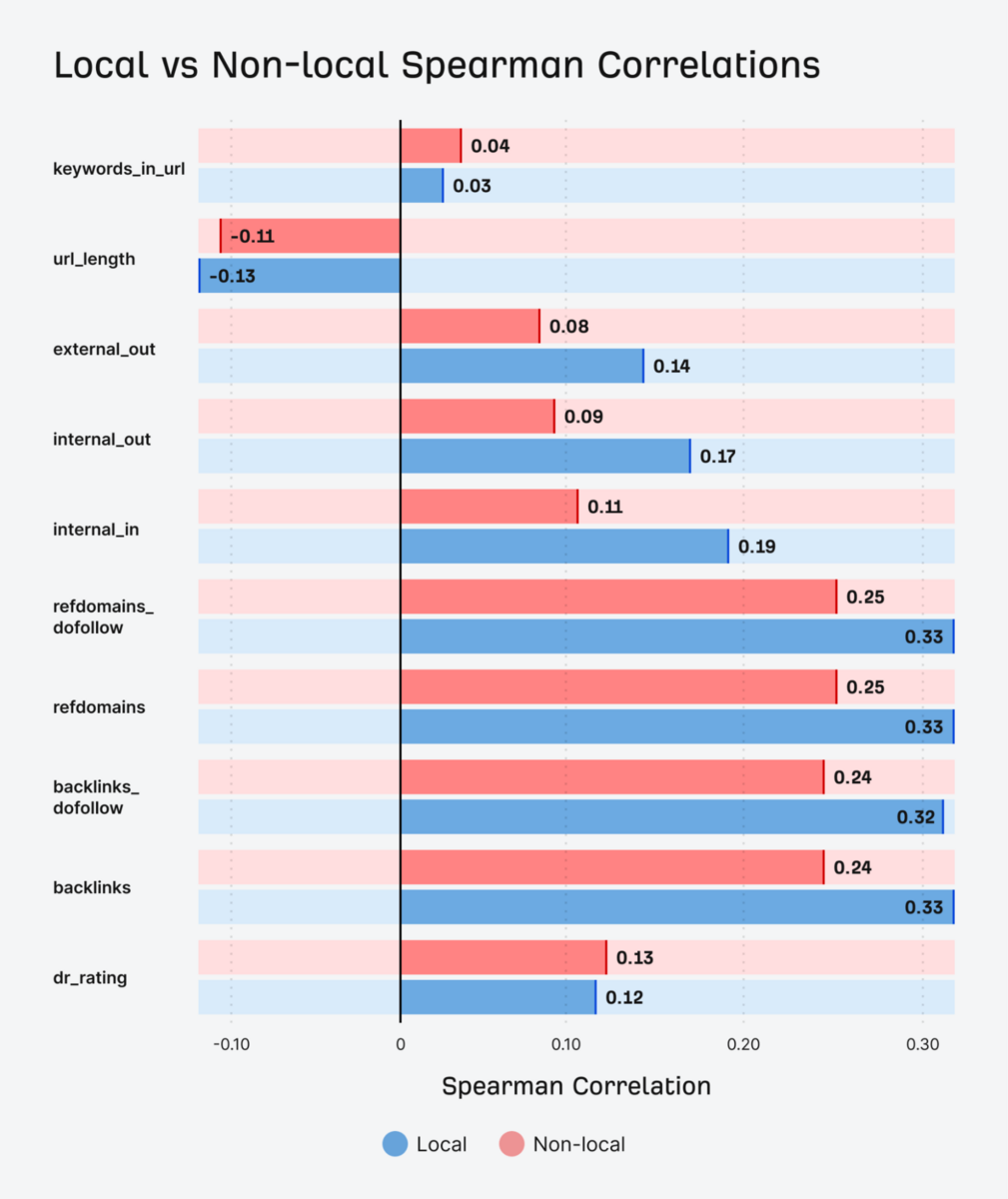
I’ve always been a big believer that when Google doesn’t have enough information, they lean on more traditional metrics like the number of links.
Therefore, in areas like local searches, where Google may not have sufficient click data, they appear to rely on backlinks to help understand rankings.
However, that doesn’t mean that all link building will have the same impact. We’ve covered the effects of relevant links extensively, and those seem to be what move the needle these days.
8. Guest posting has seen a significant increase in interest since July 2025
I’m having a hard time understanding why Google Trends is showing a surge of interest in guest posting.
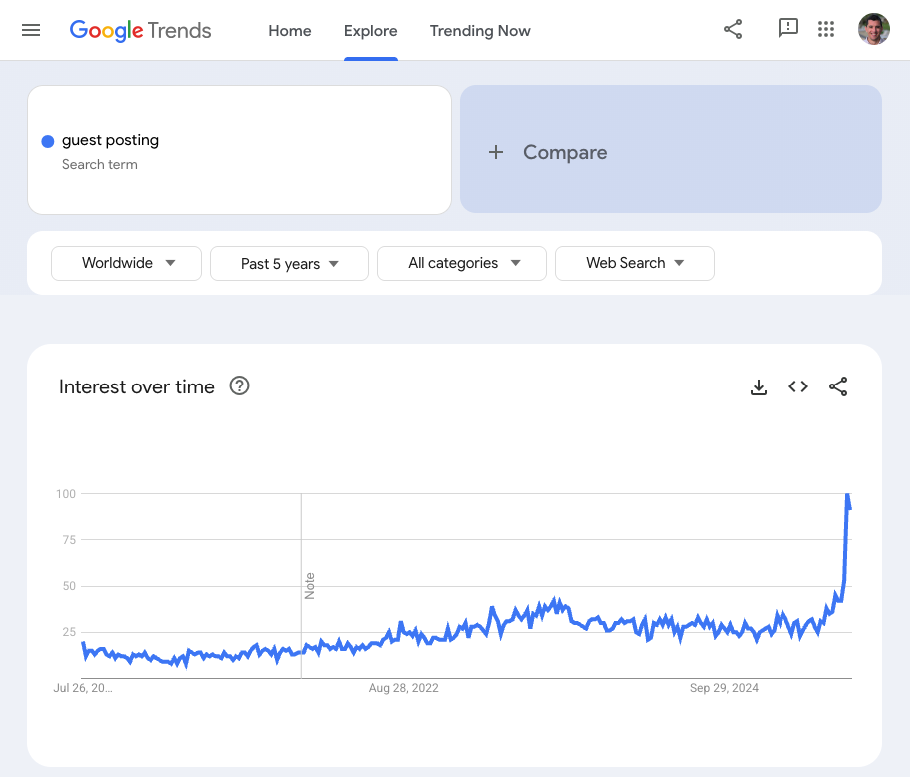
The boost seemed to happen mid-July. And I couldn’t find any news or significant studies from that time.
Link building has always been a tactic where sheer scale and brute force could help you rank. You could essentially fabricate brand trust and authority by getting links from random sites throughout the web.
I guess that this trend is due to marketers attempting to shortcut the process of building a brand through paid guest posting.
Or they are realizing links are still valuable and are trying to double down on the old tactics.
Maybe both.
Why this is important for you is that, as you’ll see in the next stat, it’s incredibly tough (and expensive) to do.
9. 85.3% of the guest posting sites are low quality
Based on a gigantic study we did on guest post costs, almost 86% of all websites found on guest post marketplaces are low quality, meaning they are below 10K monthly traffic and DR 40.
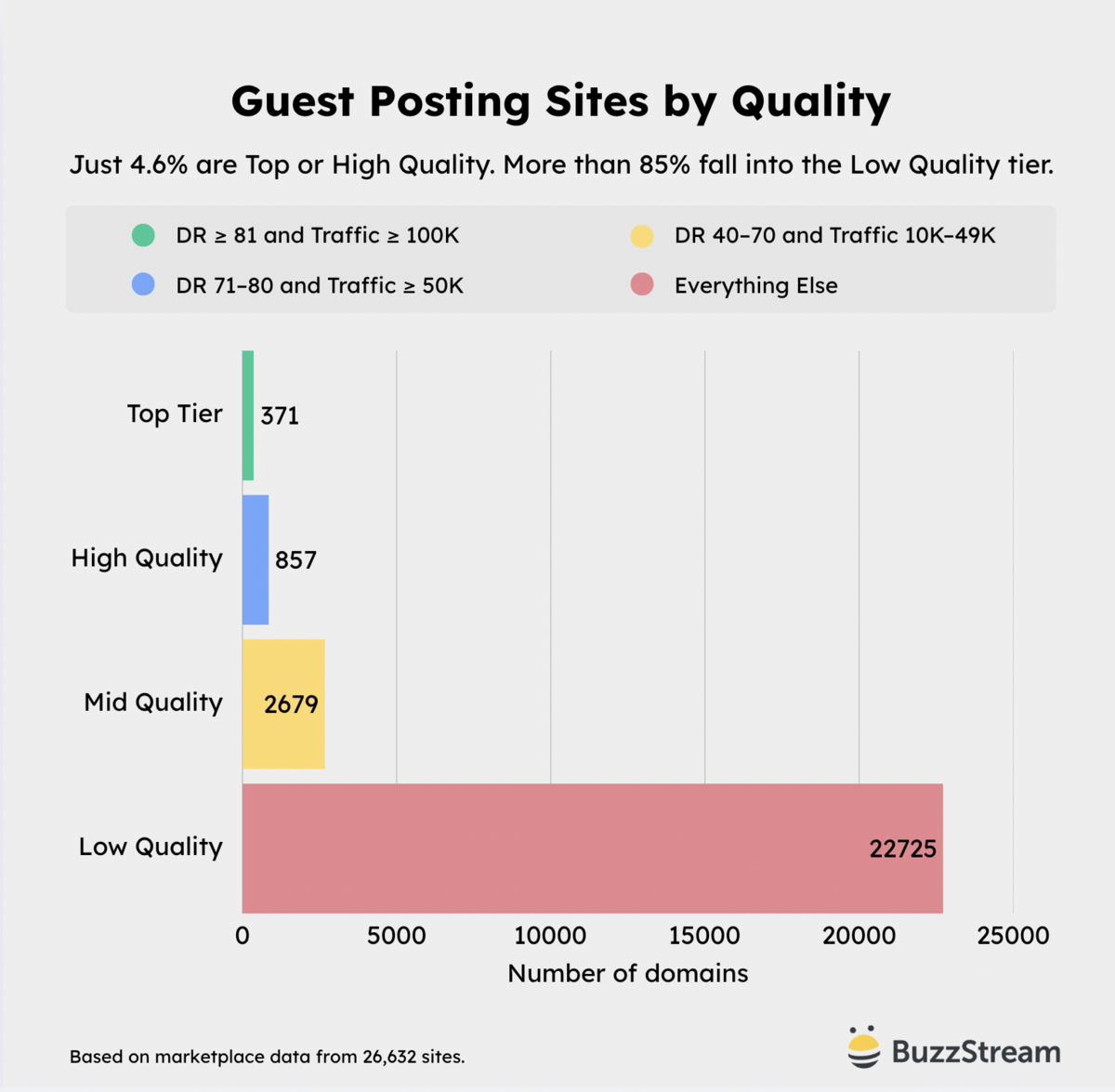
This suggests that many of the shortcuts used by SEOs and link builders to establish authority are becoming less effective.
The HCU took a sledgehammer to a lot of the sites on the list. In fact, on the list of over 26,000 guest post sites, 19% of the sites, or just about 1 in 5 had 0-100 visits per month (making them virtually useless).
10. The average cost of a high-quality or top-tier guest post is $692 – $957
Not only are there fewer quality guest post opportunities, but the ones that exist are costly.

Based on our study, these prices are before vendor markup. If you don’t have an existing relationship with a publisher or website that accepts guest posts, you’ll have to rely on a vendor. Vendor prices increase the cost of a guest post link to $ 2,500-$3,000 for those Top Tier links.
Link Building Management
Brands and agencies handle their link building strategies differently. In this section, I gathered some stats to understand how teams manage link building.
11. In our Link Building Trends Report, which we conducted in partnership with Citation Labs, we found that most organizations (61%) manage their link building entirely in-house. – (BuzzStream)
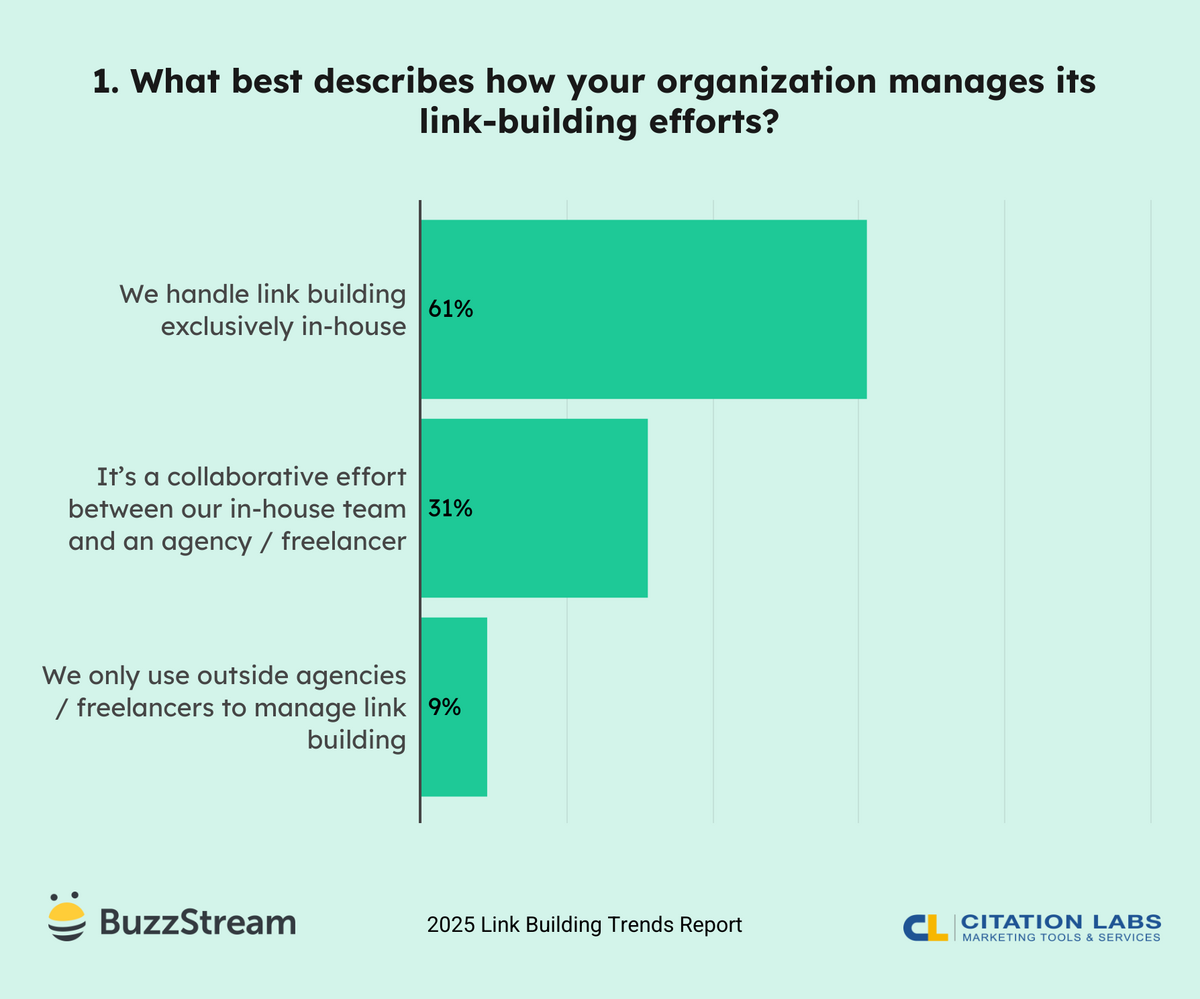
12. Almost a third employ a mix of agencies/freelancers and in-house teams. – (BuzzStream)
13. 30% of teams that work with external link builders are fully confident in the results. – (BuzzStream)
14. 66% aim to improve their ability to select the best backlink tactics for their organization. – (BuzzStream)
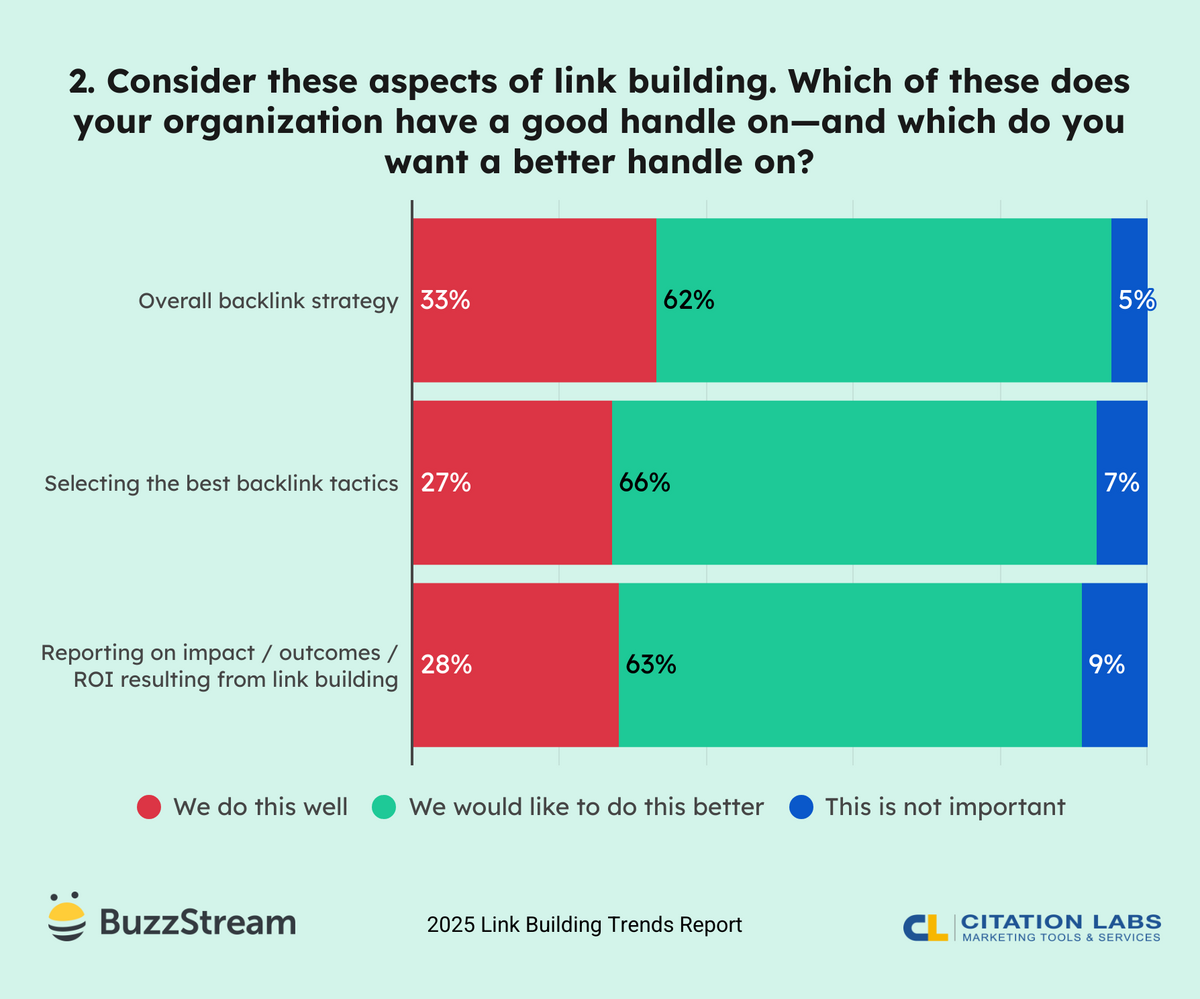
15. 63% would like to get better at reporting on impact, outcomes, and ROI from their link building efforts. – (BuzzStream)
Link Building Tools
Without the right link building tools, most strategies are dead in the water. Here are some statistics on what tools experts are using today to achieve success.
16. 59.1% of respondents in Editorial.link’s State of Link Building Report chose Ahrefs as the top all-in-one SEO tool. – (Editorial.link)
17. Google Search Console (25%) and BuzzStream (10%) are the most used tools for link building as per uSERP’s most recent study. – (uSERP)
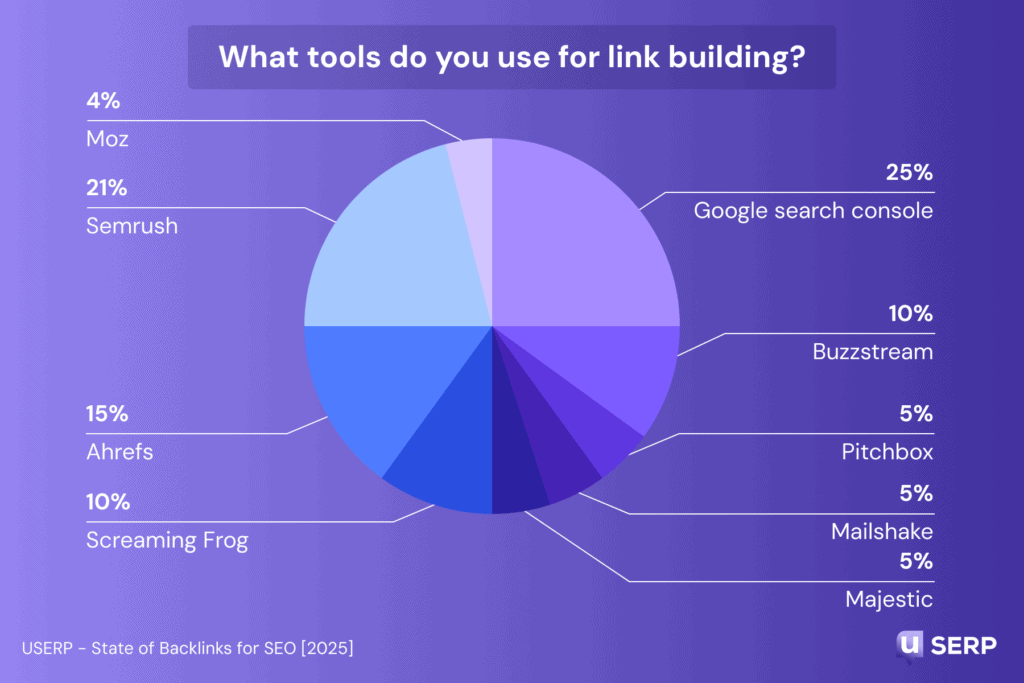
18. 56.1% cited BuzzStream as the top outreach tool for digital PR link building. This was followed by 13.9% who reported using Gmail solely for outreach. – (BuzzStream)
Link Building Strategy
Next is a compilation of strategy-related statistics to help you understand how teams are utilizing link building in 2025 and beyond.
19. Digital PR is the number one link building tactic in 2025, surpassing guest posting. (This is a repeat finding, but I wanted to highlight to stress the change in tactics.) – (FatJoe)
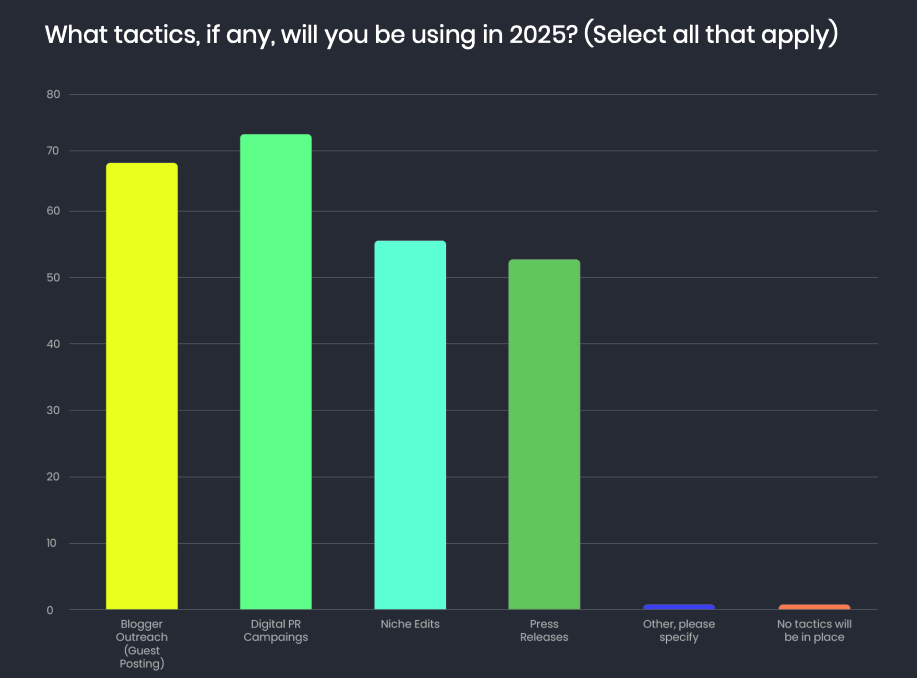
20. uSERP also found that digital PR is the most effective link building tactic (20%) followed by content marketing. – (uSERP)
21. 94.8% said that data-led content, followed by providing expert commentary (92.5%), are the primary tactics used for digital PR link building. – (BuzzStream)
22. 32% of link builders follow a documented and repeatable process. (BuzzStream)
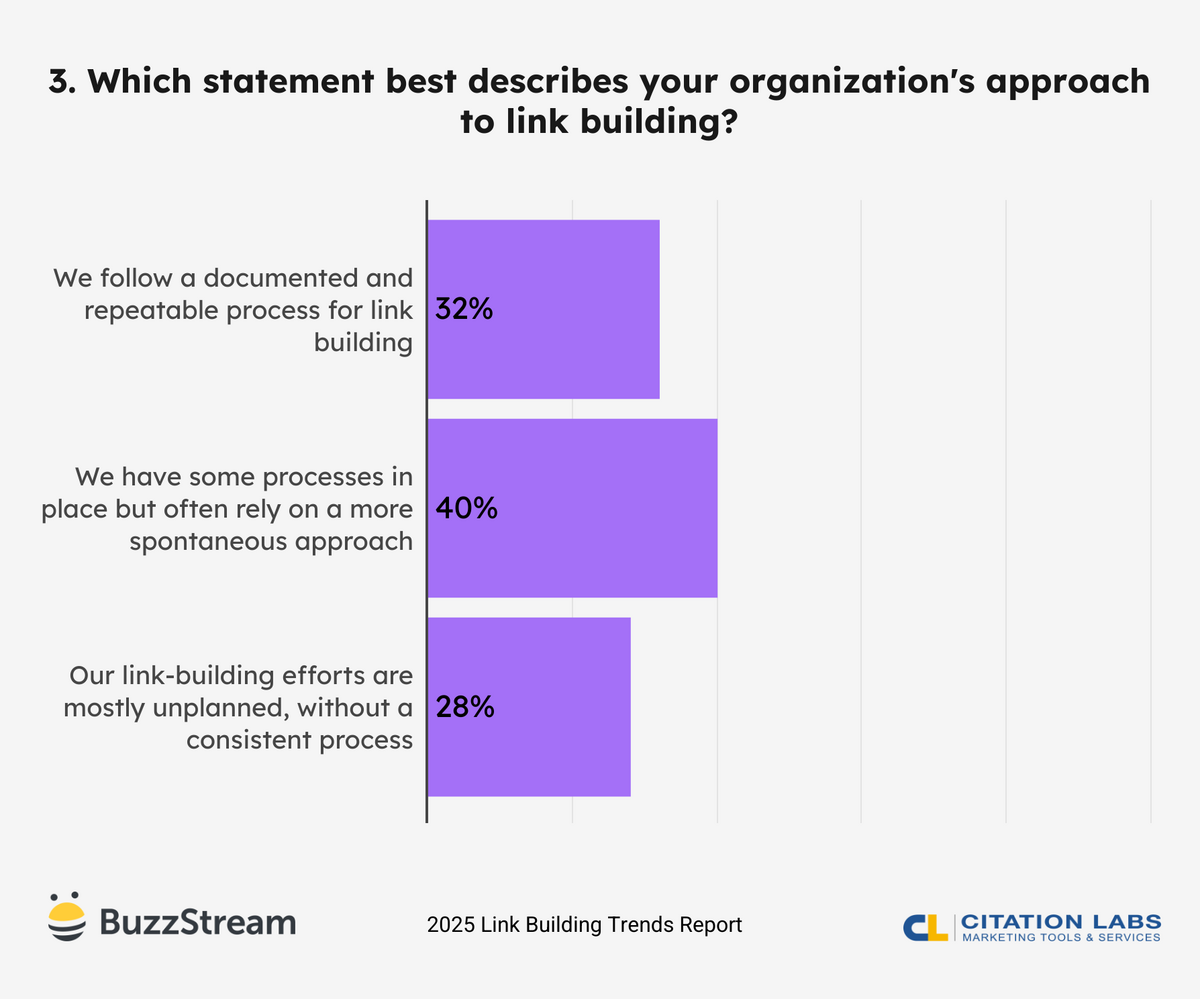
23. 68% of users reported a spontaneous or unplanned link building approach. – (BuzzStream)
24. Just 16% of link builders stick to a fixed set of strategies and rarely deviate from them. – (BuzzStream)
25. 84% maintain a flexible approach, frequently adapting and refining their strategies, while also incorporating some fixed and adaptable elements. – (BuzzStream)
26. 68% prioritize blog posts for link building campaigns, followed by the homepage (44%). – (BuzzStream)
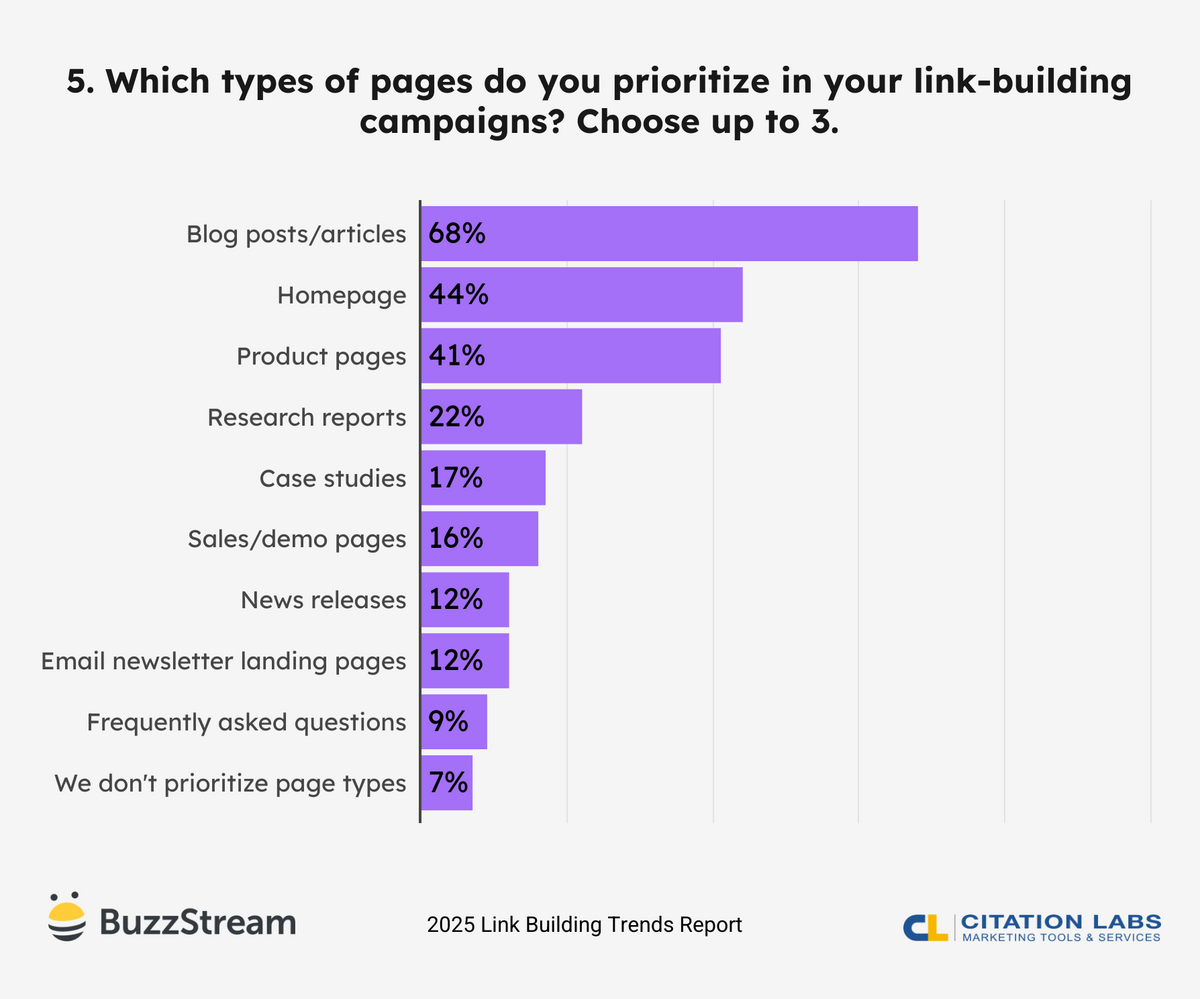
27. 41% try to build links to product pages, but only 16% try to create links to sales/demo pages. – (BuzzStream)
28. Only 16% specifically seek to build links to pages with sales-focused CTA. – (BuzzStream)
29. Approximately 29% of link builders believed that the Fashion/Beauty industry was the most challenging to build links in, followed by Education (24.9%) and Health/Wellness (21.4%). – (BuzzStream)
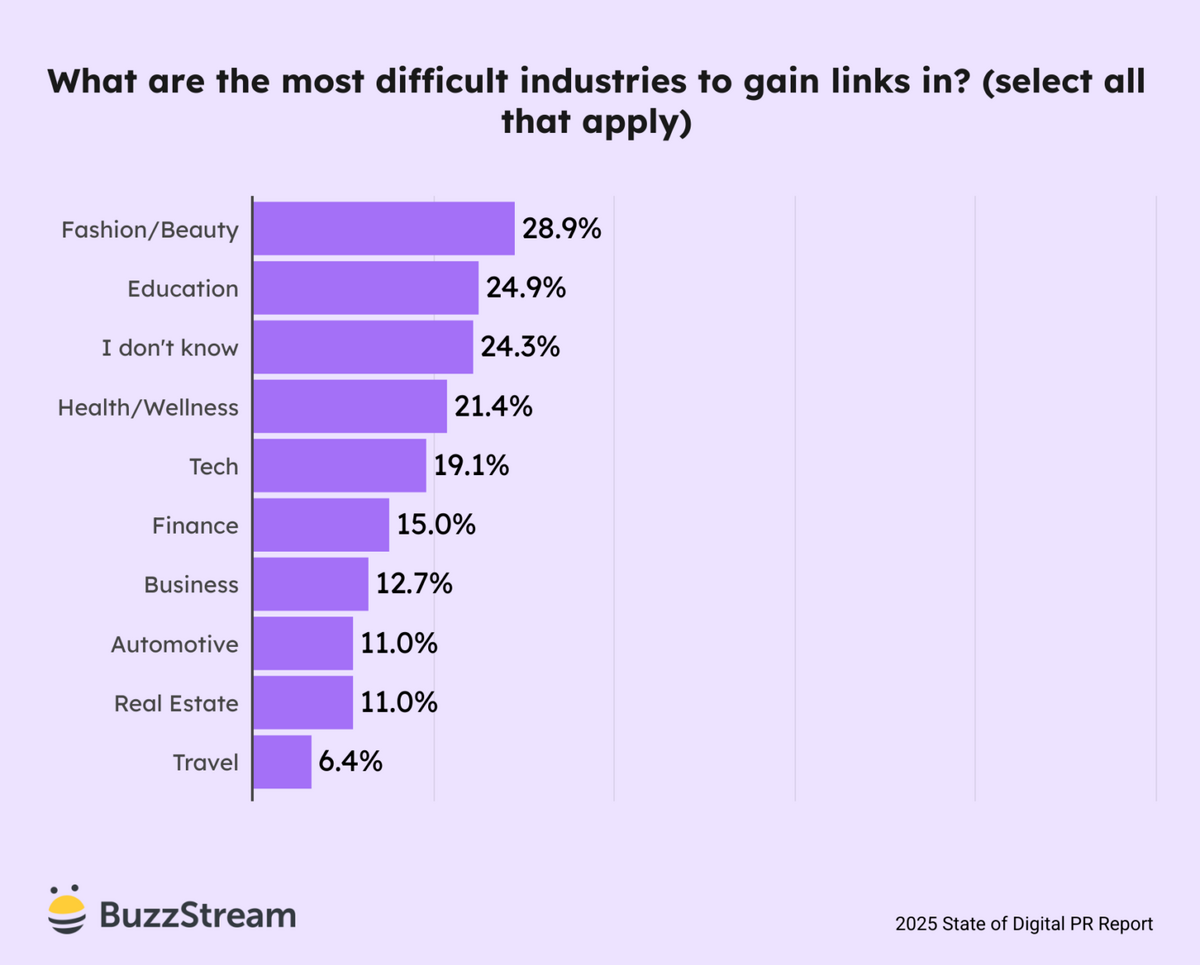
30. Almost half (45.1%) said that Travel is the easiest industry in which to build links. – (BuzzStream)
31. About 50% of digital PR link builders believe that the recent Google updates have changed their approach, while the other half didn’t. (BuzzStream)
Link Building Challenges
At the pace AI technology is advancing, there are more uncertainties than ever in the world of SEO. Plus, Google could change its algorithm at any time, rendering specific link building strategies less effective than others.
Here are some statistics on the challenges in link building in 2025.
32. 30.6% say that measuring impact is the most challenging part of digital PR link building, followed by the ideation process (29.5%). – (BuzzStream)
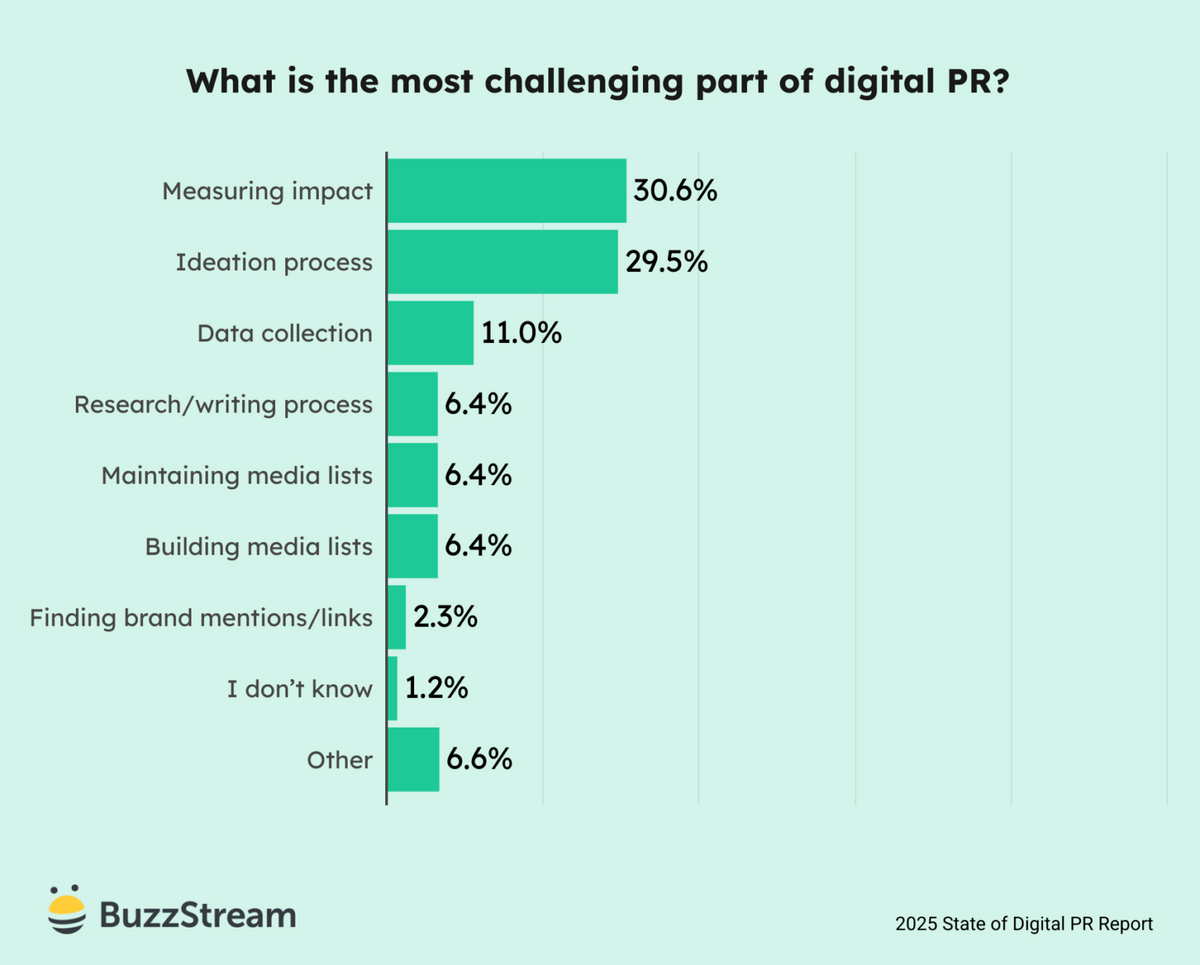
33. 71.7% of link builders agree that digital PR is more challenging than it was 12 months ago. – (BuzzStream)
34. 65% of the organizations have support from their leadership in link building as a long-term strategy (even with the challenges). – (BuzzStream)
35. 60% have just 3–6 months to show the value of their link building efforts – (BuzzStream)
36. 46.2% reported seeing measurable results from a digital PR campaign after 3-6 months. – (BuzzStream)
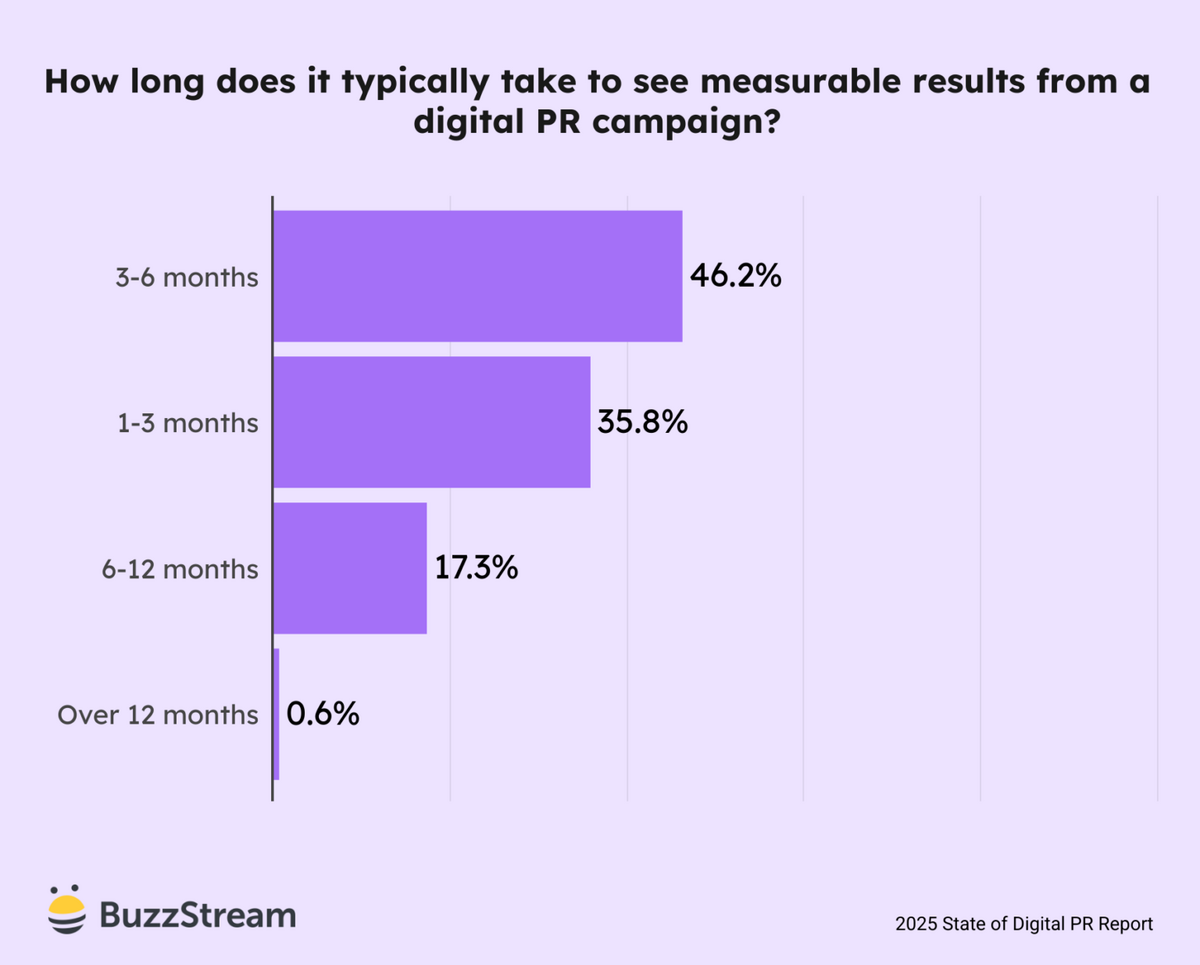
37. About 36% of digital PR link builders believe they can generate results in 1-3 months. – (BuzzStream)
38. Just 1 in 3 (30%) believe their link building efforts are successful. – (BuzzStream)
Link Building Measurement and Reporting
As you’ll see, one of the most challenging parts of link building—especially digital PR is measuring impact. This section examines the performance of different teams.
39. 59% of link builders evaluate the impact of a link by examining increased organic visibility for the target page. – (BuzzStream)
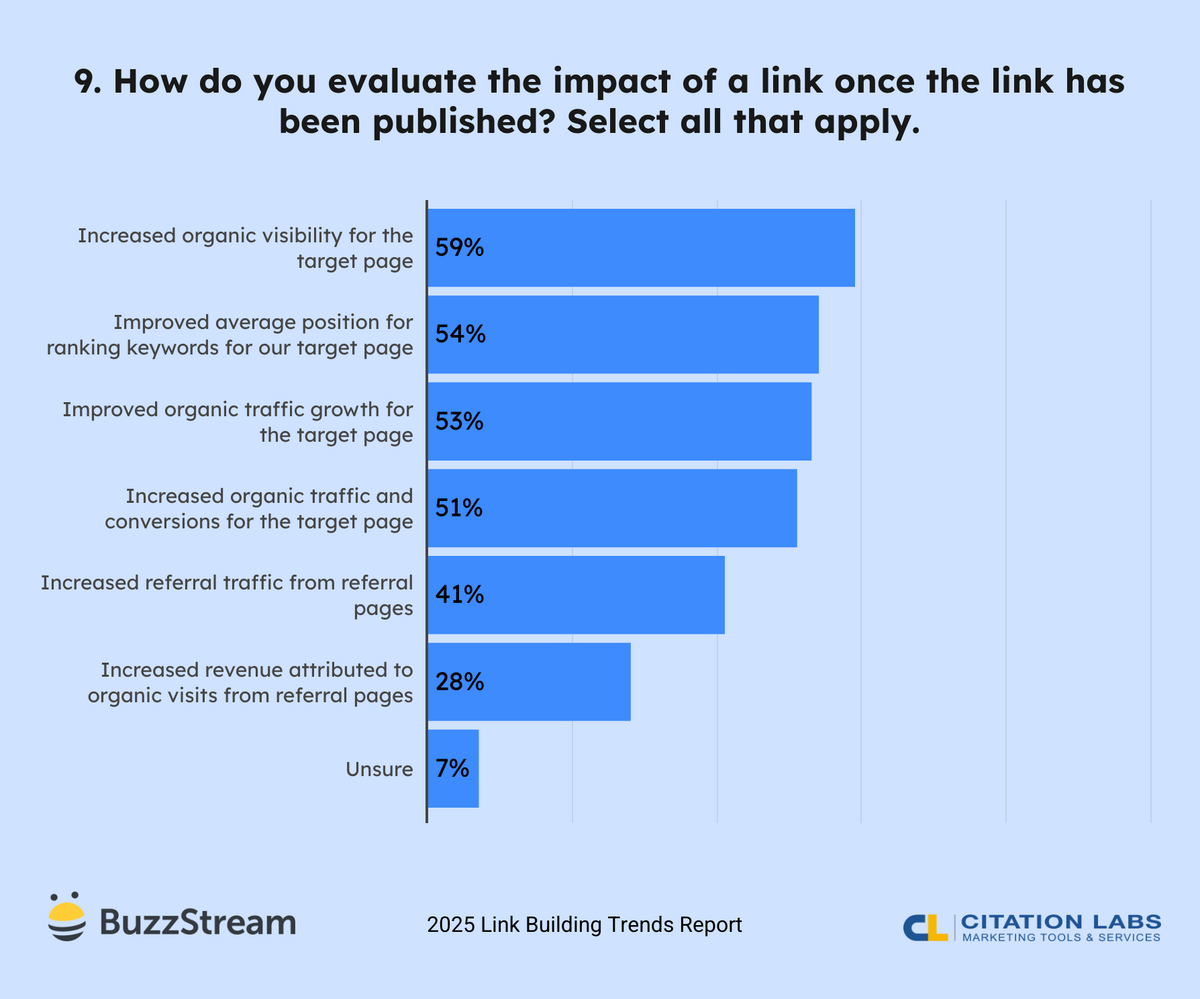
40. Just 28% measure increased revenue from organic visits to referral pages from their link building efforts. – (BuzzStream)
41. 89.6% say digital PR is most effective for building backlinks, followed by brand awareness (83.2%), and then driving organic traffic and rankings (77.5%). – (BuzzStream)
42. About 25% say that digital PR is effective for driving leads and increasing sales (18.5%). – (BuzzStream)
43. 80.9% believe unlinked brand mentions affect organic search rankings. – (Editorial.link)
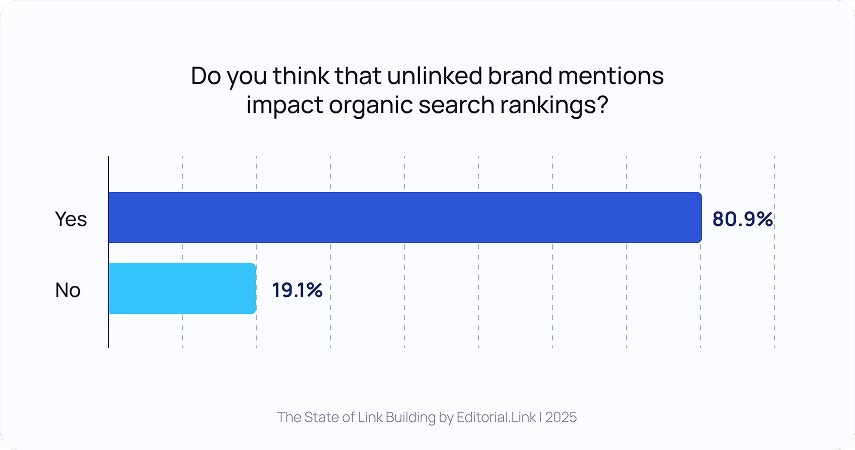
44. 67.1% say that they measure link relevancy through the page/post title. – (BuzzStream)
45. Ahrefs DR is the number one authority metric for measurement. – (BuzzStream)
46. 91.3% measure link quality through third-party metrics, such as DR/DA (91.3%) and site relevancy (86.7%). – (BuzzStream)
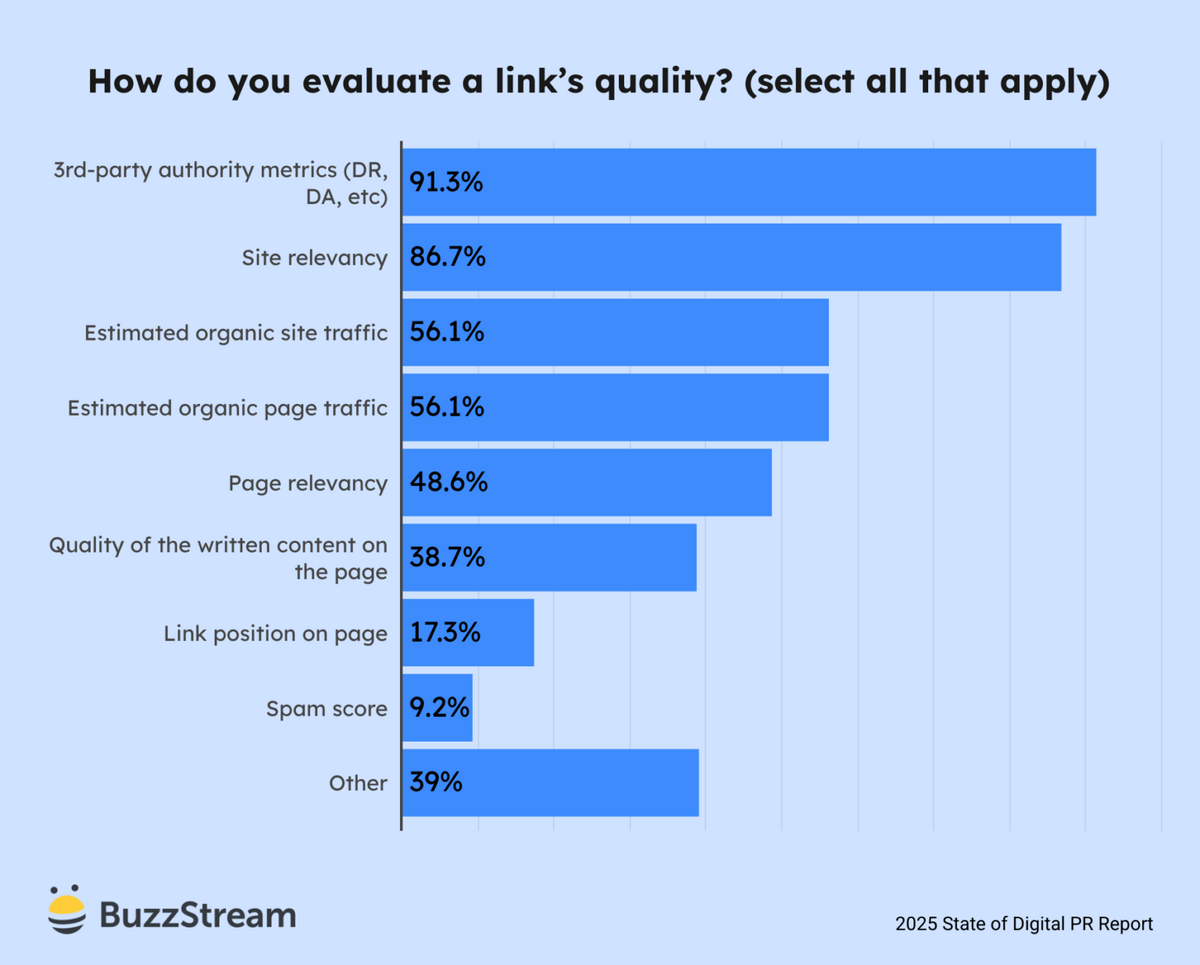
47. Almost one-third of PR pros say that they (or their team) can generate an average of 31 or more links per month. – (BuzzStream)
48. A single digital PR link builder can generate 15.58 links per month. – (BuzzStream)
49. 53.2% of digital PRs count syndicated links in their total link count. – (BuzzStream)
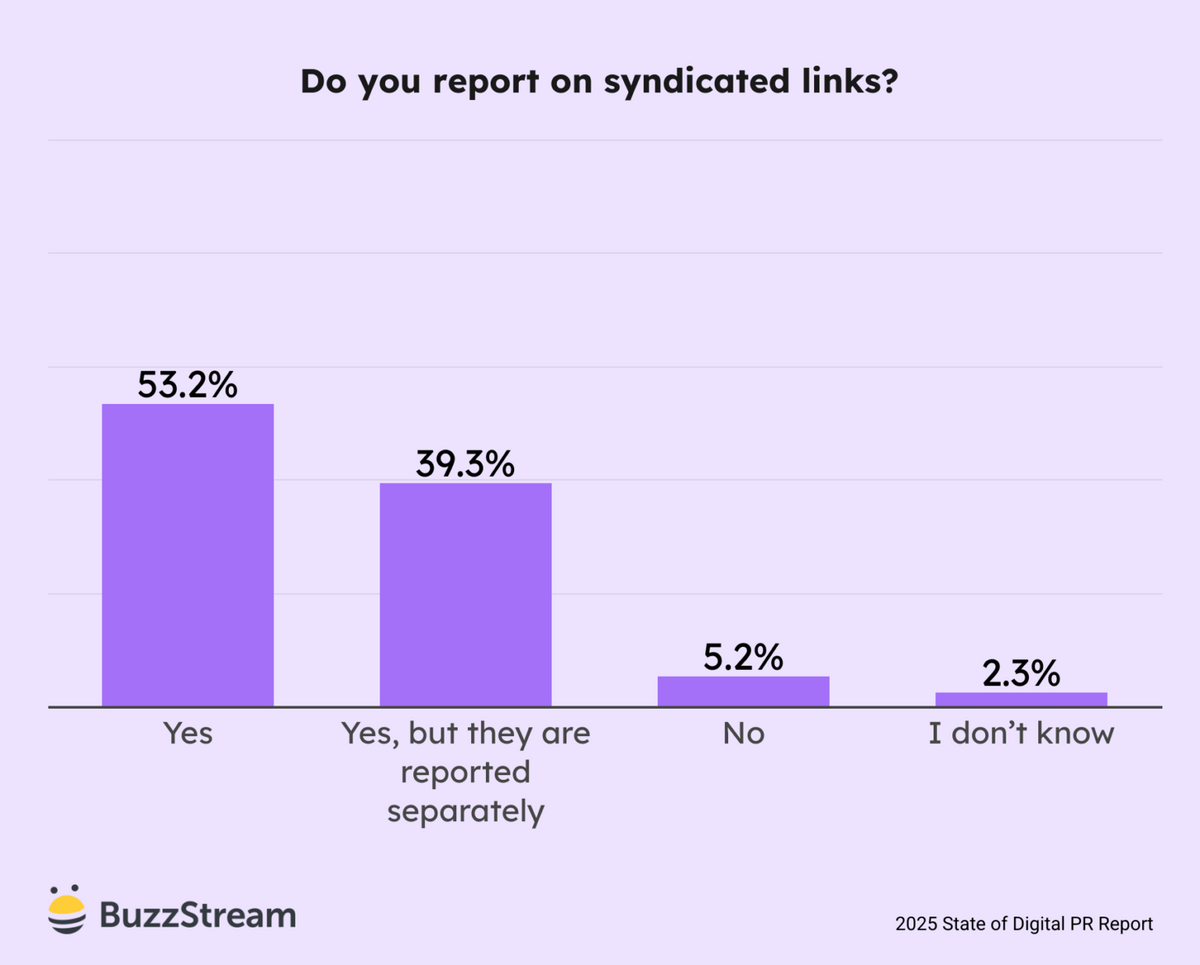
50. 70.5% report unlinked mentions separately. (And 6.9% don’t report unlinked mentions at all.) – (BuzzStream)
51. 61% of link builders align their goals with KPIs (key performance indicators). – (BuzzStream)
52. 22% of link builders don’t align their goals with any framework. – (BuzzStream)
53. Just over half (53%) of link builders believe their link building reports are easy to understand. – (BuzzStream)
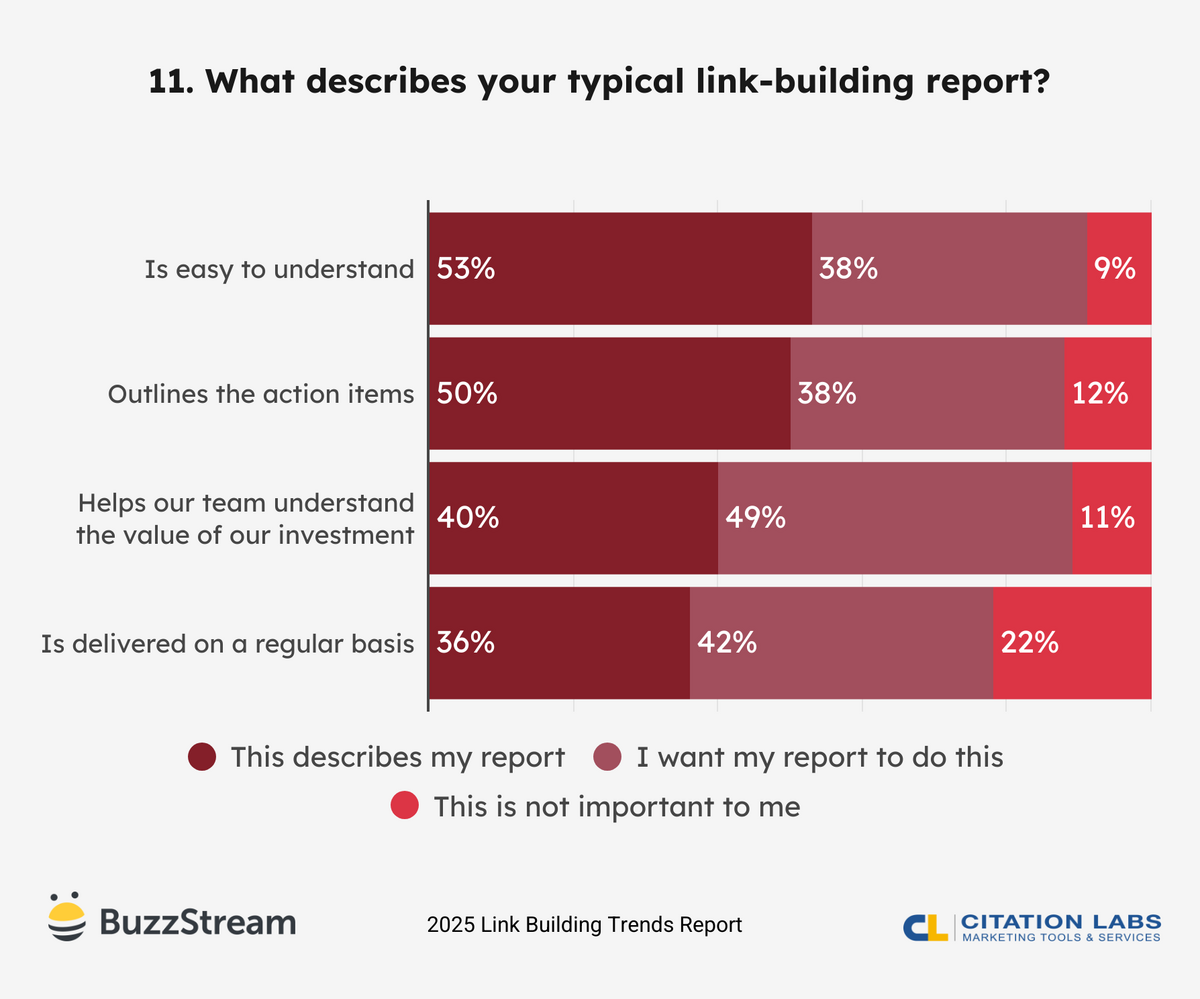
54. 40% believe their reports help teams understand the value of their investments. – (BuzzStream)
55. 25% of link builders measure their efforts against a benchmark or control group. – (BuzzStream)
Link Building Costs, Pricing, and Budgeting
With competition rising, link building pricing is also going up. We also looked at the increasing lift guest post costs in a recent report.
Here’s how link builders and SEOs are dealing with it.
56. 29% say that getting a budget for link building is easy in 2025. – (BuzzStream)
57. 66.5% of link builders doing digital PR operate with budgets below $10,000 per month. – (BuzzStream)
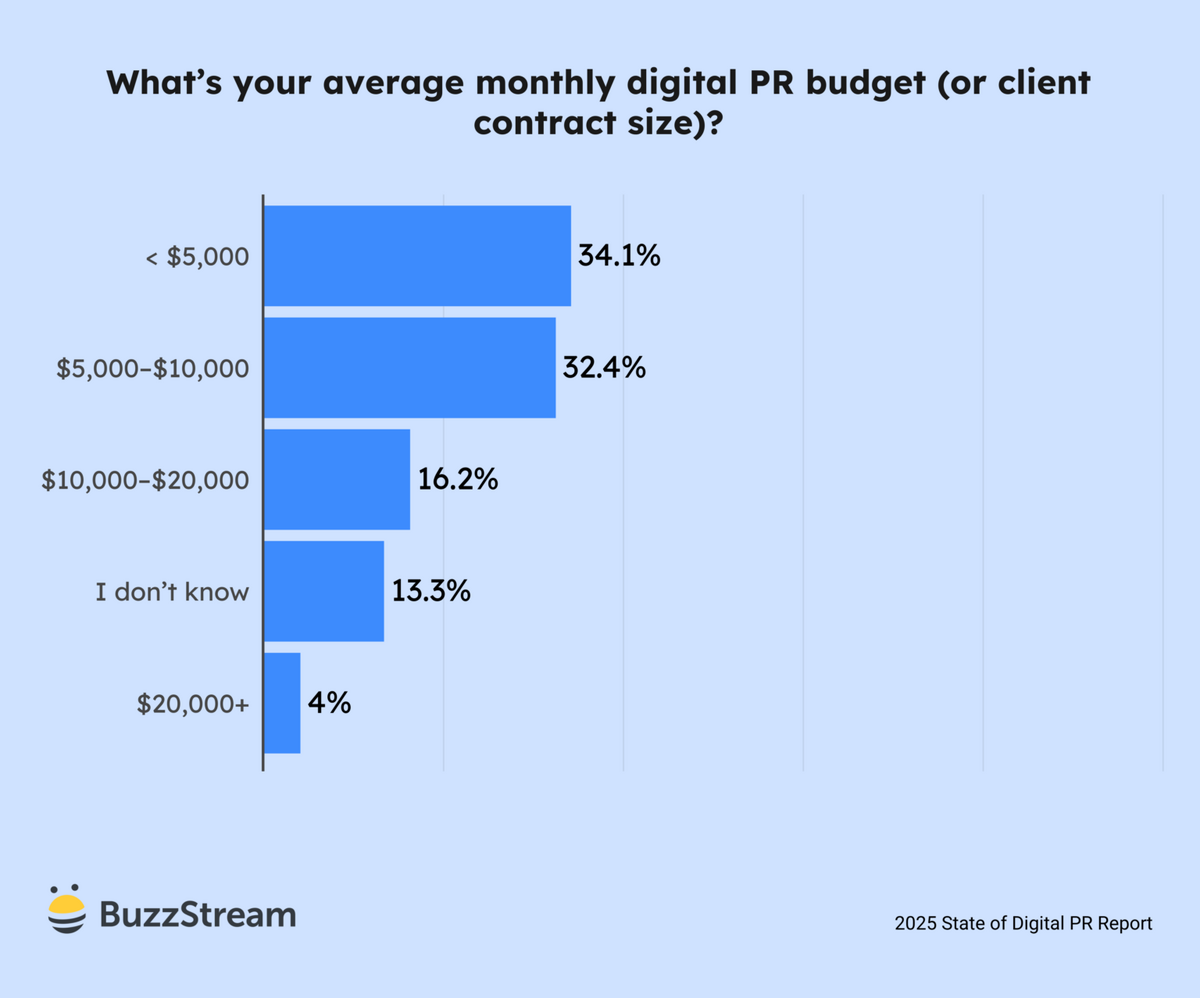
58. Almost 81% believe link-building costs will rise over the next 2–3 years. – (Editorial.link)
59. About 61% say that the igaming/gambling industry requires the highest link-building budgets. – (Editorial.link)
60. Link builders in the legal industry appear to spend the most on link building – (FatJoe)
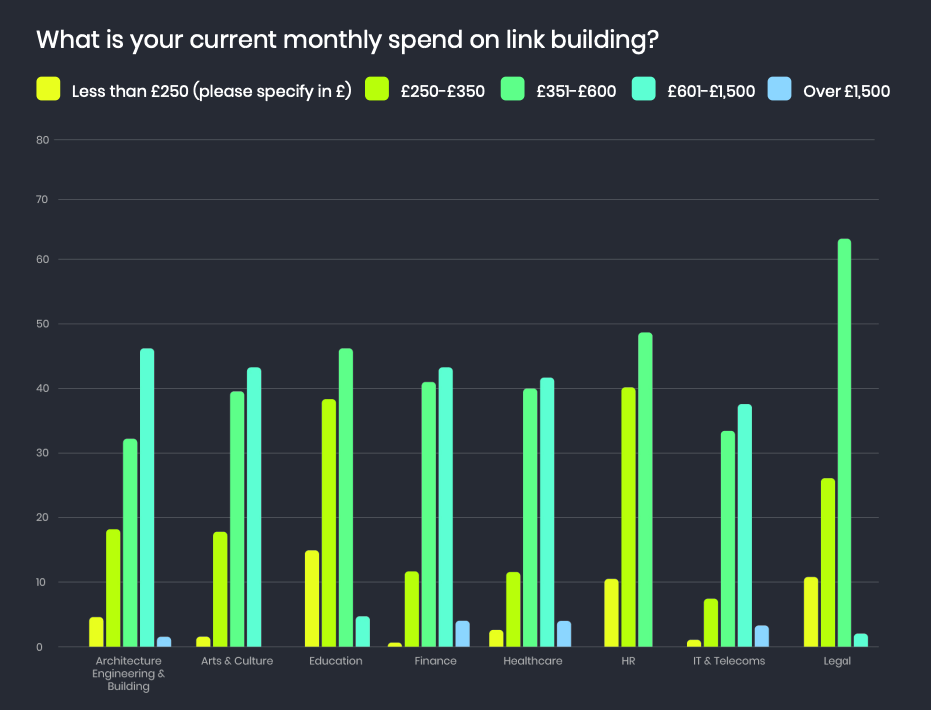
61. Most organizations invest in link building to improve organic traffic (68%) and improve rankings (68%). – (BuzzStream)
62. Only half build links to increase sales/revenue (48%), and just 39% want to generate leads or email signups. – (BuzzStream)
63. Over half (56%) of link builders plan to invest more in link building in the next 12 months. – (BuzzStream )
64. About 61% of marketers plan to invest in link building in 2025 to help improve their rankings. -(BuzzStream)
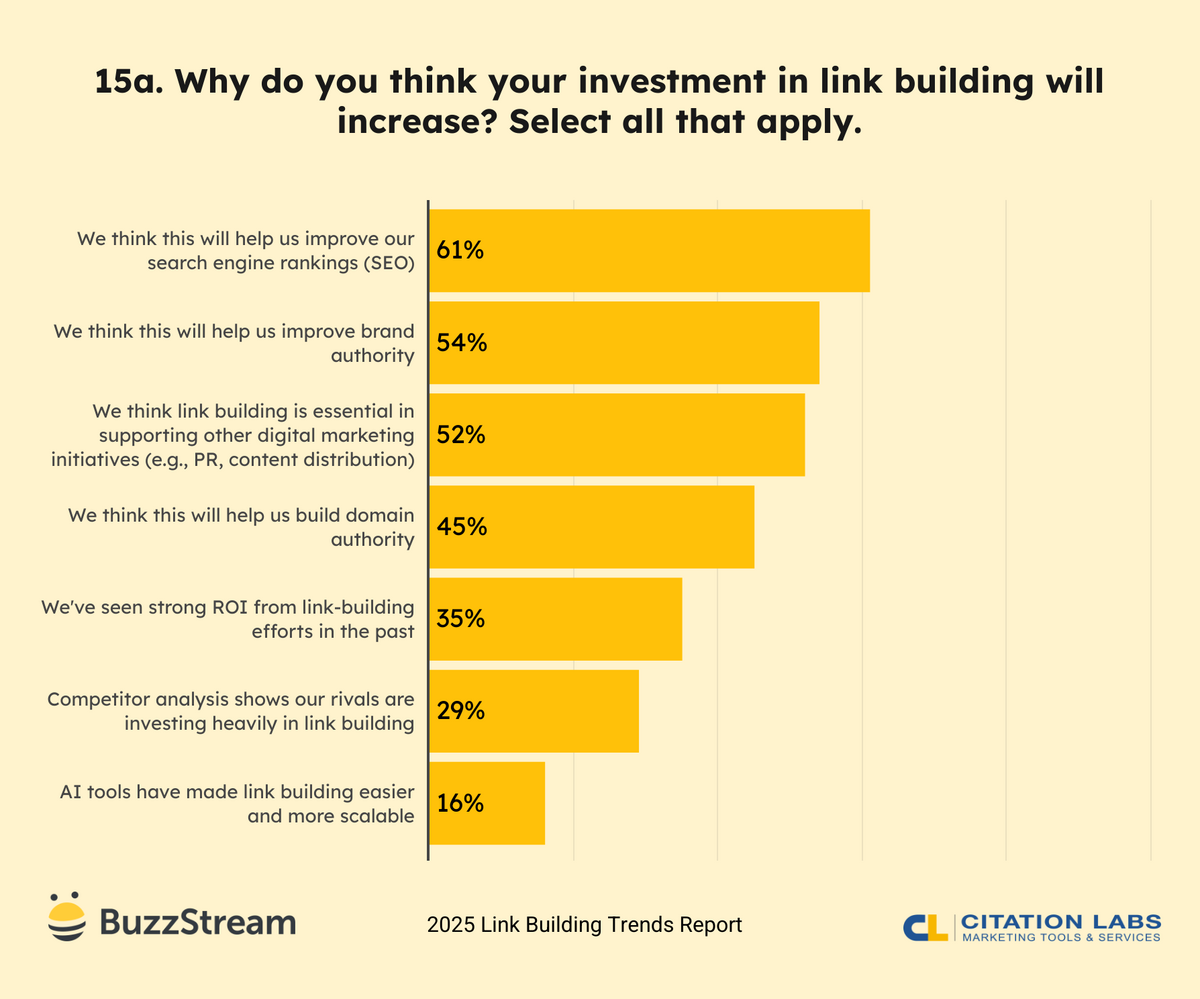
65. Only 39% will decrease link building spend in 2025 (and it’s mostly due to budget cuts). – (BuzzStream)
66. Just 9% of SEOs plan to decrease their link building budgets because of AI. – (BuzzStream)
67. The average cost per link (CPL) for digital PR link builders is $750, although approximately 25% fall within the $300-$ 750 range. – (BuzzStream)
68. 51.4% of digital PR-focused link builders are unaware of their average cost per link. – (BuzzStream)
69. The average estimated guest post cost is $364.76 (before an assumed 75% markup from vendors). – (BuzzStream)

70. Almost 9 out of 10 digital PR link builders (87.3%) say they never pay for link placements. – (BuzzStream)
AI in Link Building
Last, we come to AI. This section will likely be much larger in subsequent years, but since everyone is still trying to figure out where things are headed, here are the statistics that stood out to me.
71. Two-thirds (68%) believe link building will be more important (68%) in the next two years due to AI. – (BuzzStream)
72. 62% of link builders are prioritizing obtaining citations in AI-generated results. – (BuzzStream)
73. About three-quarters of link builders (73.2%) believe backlinks influence the chance of appearing in AI search results. – (Editorial.link)
74. Just 11% claim to have a repeatable, reliable process for getting cited in AI-generated results. – (BuzzStream)
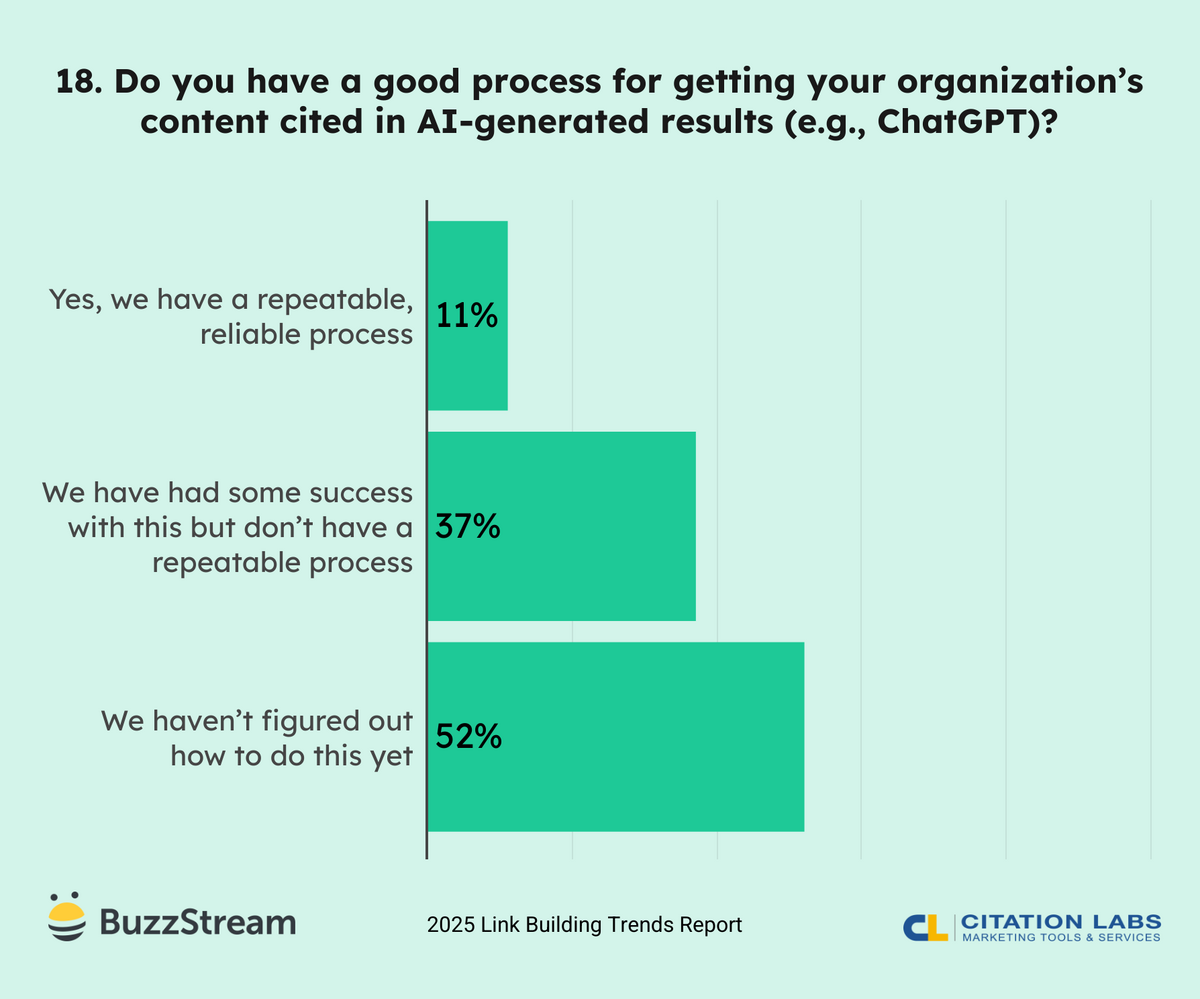
75. 43% of link builders use AI for creating content, such as guest posts. – (BuzzStream)
The Future of Link Building
Currently, showing up in AI results appears to be the primary concern in the SEO world.
Luckily (or unluckily for some), spammy link building doesn’t seem to be a reliable strategy for showing up there.
Our bets have been on building real links through quality, data-driven content that doesn’t exist anywhere else.
That’s what link building using digital PR is all about and why we created ListIQ to help build better media lists to find journalists who are interested in getting you links and coverage.

 End-to-end outreach workflow
End-to-end outreach workflow



 Check out the BuzzStream Podcast
Check out the BuzzStream Podcast

